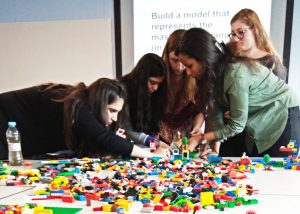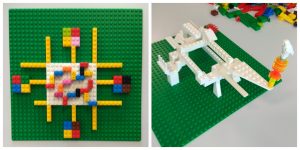Tauheed Ramjaun, Lecturer In Corporate Communications, FMC attended a Lego workshop run by the Centre of Excellence. CEL has boxes of lego to loan out if you are interested in using it for education. Here is his report of using Lego.
During this first week of teaching, I had the opportunity to apply the LEGO® SERIOUS PLAY® in a postgraduate unit related to analysis and decision-making in communication management. The workshop was designed based on a CEL training I attended in 2016 as well as various instructional materials consulted online.
I wanted my students to understand how this type of workshop could allow for participants to express their views in a more democratic way, where they could be encouraged to drift from their habitual way of thinking and be also given the opportunity to develop more imaginative scenarios.
Firstly, I spent around twenty minutes explaining the theoretical principles behind the LEGO® SERIOUS PLAY® approach. Then, after a break, I started the practical workshop with some warm-up exercises inspired from the Lego open-source training manual and other practitioner sources. After these exercises which lasted around thirty minutes, participants were then introduced to their main building challenge.
I am currently involved with revalidation of the MA degrees in my department. So, I used this practical workshop as an opportunity to capture insights from freshly recruited postgraduate students. At the same time, these students would get a hands-on perspective of how this method is applied in a real-life professional context. Participants were therefore asked to build a model that represents their thoughts about the postgraduate communication degree of the future after being explained the context of this exercise.
After the model building exercise, participants were given the opportunity to explain their models respectively. While expressing their thoughts, I noted that there were some interesting metaphors being used and I also found it fascinating to see how elements of shape, space and colour were being used to express abstract ideas in a tangible manner.
Participants were then asked to build one final model as a group that would combine the main themes generated from the individual models. Each participant was invited to comment on this final model and the workshop ended with participants being asked to fill in an evaluation questionnaire about their experience.
It seems that what students liked best about this workshop was that it was a “fun way to work as a team”, it was a “brain stimulation activity”, and that it “got everybody involved”. However, one participant mentioned that while she mostly enjoyed the experience, she also found it difficult to express her ideas through the Lego pieces. I concluded the session by reminding participants that, as with many methodologies, the LEGO® SERIOUS PLAY® has both certain advantages and limitations.

Reflecting upon this exercise and looking at the feedback from participants, I feel that the building challenge assigned to them could have been better articulated. There could also have being more time allocated to the whole process. Though I used thirty minutes of lecture time to explain the method and then two hours for the practical workshop, I believe that more time is needed to allow for a better immersion into the process as well as allowing for more interaction among participants.
Overall, I enjoyed introducing students to this unconventional method which they could potentially apply and adapt to their own professional contexts in the future.








